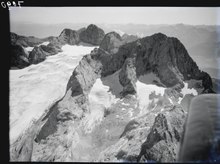Torstein Glacier

The three Kar glaciers (small (st) glaciers or firn spots) in the western Dachstein massif are called Torstein glacier .
General
While the term Torstein Glacier or Torstein Glacier for the coherent glaciation of the high northwest exposed Kare des Torstein ( 2947 m ) found its way into the literature at the time of the glacier high position of 1850 , today the term is used collectively for the Small Gosaugletscher , the Northern Torstein Glacier and the Southern Torstein Glacier (-firn).
The high level of 1850 and the retreat phases of the Torstein glacier
Around the middle of the 19th century, the cirques in the northwestern Torstein roof were under a closed blanket of snow, and the ridge between the Little Gosau Glacier and the Northern Torstein Glacier was buried deep under firn in 1844 , both stretched without gaps to the Eiskarlspitze, even in 1885 Friedrich Simony still speaks of it a contiguous "Thorsteingletscher". At the end of the 1880s, there were increasing signs of a separation between the Kleiner Gosau Glacier and the Northern Torstein Glacier, and it was also recognized that a patch of glacier in the western Windlegerkar is to be regarded as an independent ice field and thus as the Southern Torstein Glacier. Roman Moser also sets the separation of the northern Torstein glacier from the Kleiner Gosau glacier in the years 1884 to 1896. Moser's description of a left lateral moraine of the northern Torstein glacier and a right bank wall of the southern Torstein glacier suggests that the two Torstein glaciers also only existed at the height of 1850 in the nutrient areas were connected by a closed firn cover.
Friedrich Simony assumed the maximum level of the Torstein glacier in the high phase around the middle of the 19th century at the same time as that of the Great Gosau Glacier (1848/49) and set the glacier foot at approx. 2160 m. In 1893 the separation had progressed so far that the glaciers were only connected by a narrow layer of firn snow, the final separation of the Kleiner Gosaugletscher from the northern Torstein Glacier took place in the following years. Once isolated, both melted away very quickly and retreated into the deeply cut small caves of the peat stone walls. For example, the Kleine Gosau Glacier had retreated from 2150 m at the 1850 high point 100 years later by around 480 m to an altitude of 2245 m. For the northern Torstein Glacier, the retreat path of the end of the tongue was even more than 800 m, it ended in 1953 at an altitude of around 2400 m.
With regard to older moraines, only the 1850 high level at the joint tongue of the Kleiner Gosau glacier and the northern Torstein glacier can be clearly identified; the moraine material on the southern Torstein glacier has slipped so much that the extent of 1850 is only approximately where the Steig from the Windlegerscharte turns steeply downwards, lets determine.
source
- Rainer Hochhold, 1978: The glaciers of the Dachstein group . Geographic Institute of the Univ. Innsbruck. Digital copy: The glaciers of the Dachstein group p. 84ff
literature
- Erik Arnberger , Erwin Wilthum: The glaciers of the Dachsteinstock in the past and present II. In: Yearbook of the Upper Austrian Museum Association. Volume 98, Linz 1953, pp. 187-217, online (PDF) in the forum OoeGeschichte.at.
- Roman Moser: The glaciation in the Dachstein and its traces in advance. Dissertation at the Geographical Institute of the University of Innsbruck, 1954.
- Roman Moser: Dachstein Glacier and its traces in advance. Musealverein Hallstatt (Ed.), Hallstatt 1997, 143 pages.
- Friedrich Simony: The Dachstein area. A geographical character image from the Austrian Northern Alps. E. Hölzl, Vienna 1895, 152 pages.